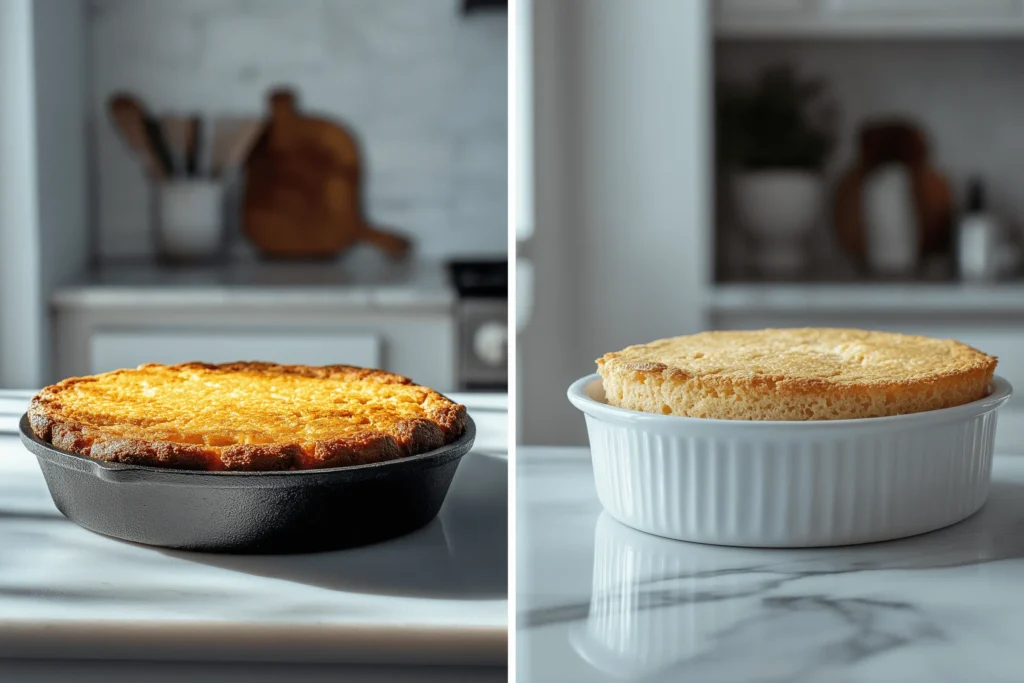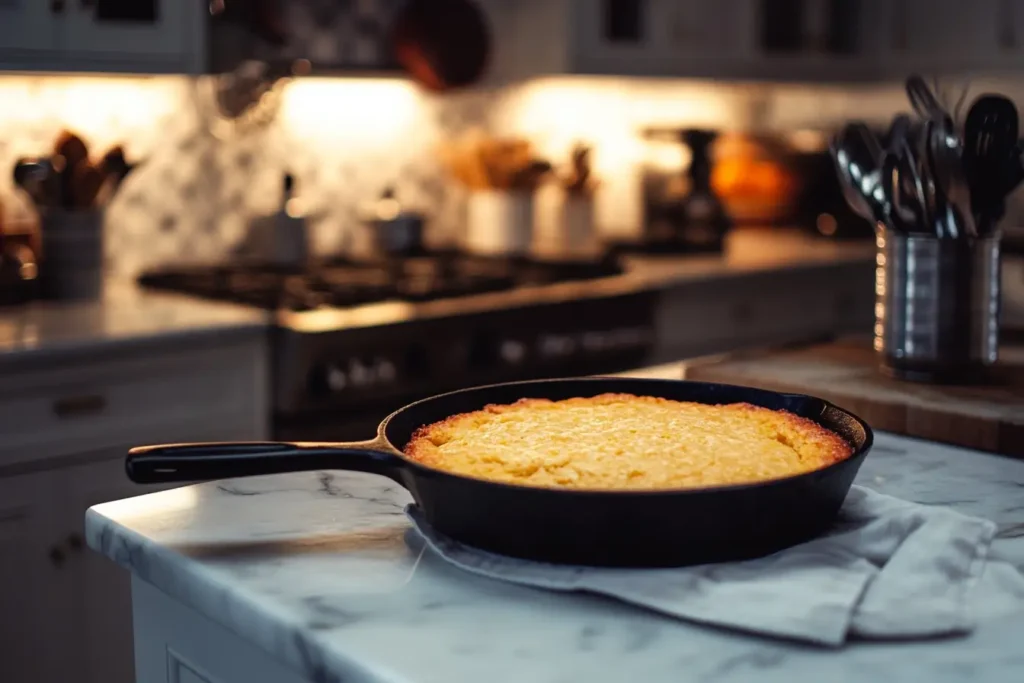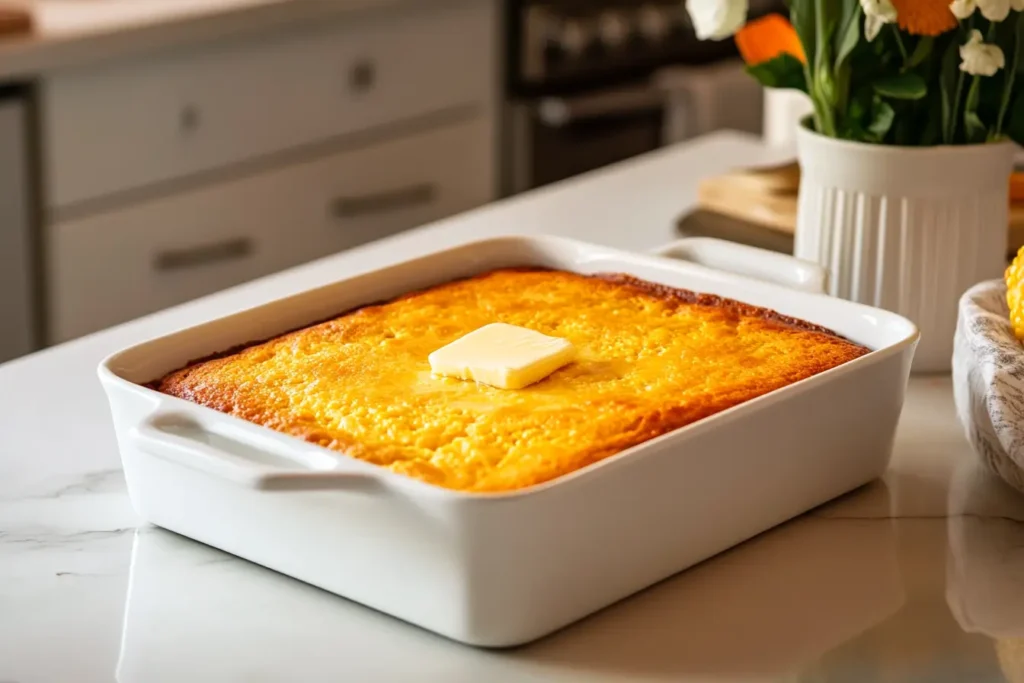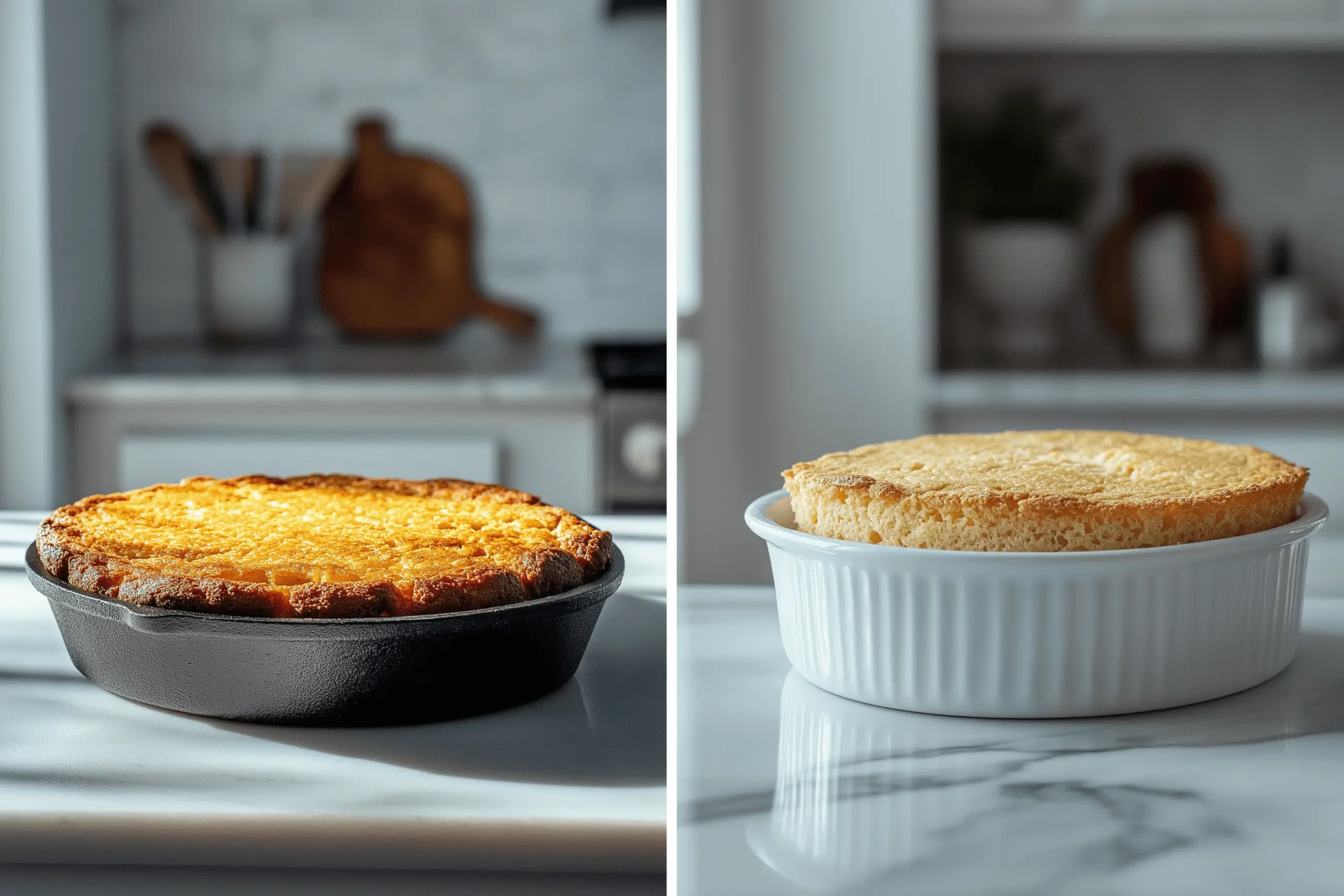
When you think of cornbread, you might picture that golden, crumbly goodness that shows up at BBQs, Thanksgiving feasts, or alongside a hearty bowl of chili. But did you know there’s a big difference between Southern cornbread and what many call “regular” cornbread? Yep, it’s not just about where you’re from—it’s about ingredients, preparation, and flavor. Stick around as we dig into what sets these two cornbread cousins apart. 🥖🌽
Introduction to Cornbread: A Culinary Staple
Cornbread has been a beloved part of American cuisine for centuries. It’s simple yet versatile, and people just can’t seem to get enough of its warm, comforting vibes. But here’s the thing: not all cornbread is created equal. The type of cornbread you grew up with likely depends on where you live or what traditions your family followed.
Cornbread’s charm lies in its adaptability. Want it sweet? Go for it. Prefer it savory? That works too. And it pairs well with just about anything—soup, meat, or even as a snack on its own. But before we dive into the nitty-gritty of Southern versus regular cornbread, let’s explore the backstory.
A Brief History of Cornbread in American Cuisine
Cornbread’s story begins long before Europeans landed in America. Indigenous peoples were grinding corn into meal and using it to make flatbreads, a practice that laid the groundwork for what we know today. When settlers arrived, they adopted and adapted these methods, creating variations of cornbread as they moved across the country.
Fun fact: Corn was a lifesaver during tough times, especially in the South. Wheat flour wasn’t always available, but cornmeal was cheap, plentiful, and nutritious. Over time, Southern cooks put their spin on cornbread, creating a version that was distinct from what you’d find in the North or Midwest.
“Cornbread is like a blank canvas—every region, every family paints it differently.” 🌽✨
Cultural Significance of Cornbread Across Regions
Cornbread isn’t just food—it’s culture. In the South, it’s a deeply ingrained tradition, often tied to comfort and nostalgia. Families pass down recipes, and you’ll hear heated debates over whether sugar belongs in cornbread (spoiler: Southern purists say no).
In other regions, cornbread takes on a more casual role, often leaning towards sweeter, cake-like versions. Regular cornbread is the type you’re more likely to find at a mainstream grocery store or as part of a meal in non-Southern states.
Southern Cornbread: Characteristics and Tradition

When you hear “Southern cornbread,” you might immediately think of cast-iron skillets, a crunchy crust, and a flavor that’s savory with just a hint of richness. Let’s break it down further.
Key Ingredients in Southern Cornbread
Southern cornbread keeps things simple and savory. Here’s what you’ll usually find in the recipe:
- Cornmeal: The star of the show. Southern cornbread often uses yellow cornmeal for that deep golden hue.
- Buttermilk: Adds tanginess and a moist texture.
- Eggs: Help hold everything together.
- Fat: Typically bacon grease or butter for a rich, flavorful edge.
- No Sugar: Yep, Southern cornbread is famously sugar-free. Adding sugar is almost considered blasphemous in traditional Southern kitchens.
Unique Preparation Methods of Southern Cornbread
Southern cornbread is all about the skillet. A hot, well-seasoned cast-iron skillet gives the bread its signature crispy edges. Here’s the trick: you preheat the skillet in the oven with some fat before pouring in the batter. This creates a sizzling crust that’s absolutely irresistible.
Another hallmark? Southern cornbread leans crumbly, not cake-like. It’s made to complement savory dishes like collard greens or beans rather than steal the show.
Flavor Profile of Southern Cornbread
Imagine taking a bite of Southern cornbread. It’s slightly tangy from the buttermilk, earthy from the cornmeal, and rich from the bacon grease or butter. No sweetness here—it’s all about that hearty, savory vibe. It’s the kind of bread that makes you want to sop up the last bit of gravy on your plate.
“Southern cornbread doesn’t need sugar—it’s bold enough to stand on its own.” 💪
Regular Cornbread: A Broader Perspective

Now, let’s talk about what most people think of when they hear “cornbread.” Regular cornbread is a little sweeter, softer, and less divisive than its Southern counterpart.
Common Ingredients in Regular Cornbread
Regular cornbread often includes:
- Cornmeal: Sometimes mixed with all-purpose flour for a softer texture.
- Milk: Instead of buttermilk, plain milk is common.
- Eggs: For binding and fluffiness.
- Fat: Typically butter or oil.
- Sugar: Yep, it’s sweeter—think somewhere between bread and cake.
This combination makes it lighter and more universally appealing, especially for those who prefer a touch of sweetness in their bread.
Differences in Preparation Styles
Unlike Southern cornbread, regular cornbread doesn’t require a cast-iron skillet. You’ll often see it baked in a standard baking pan or even as muffins. The texture tends to be softer and less crumbly, making it easier to eat on its own or as a side dish.
Taste and Texture of Regular Cornbread
If Southern cornbread is bold and rustic, regular cornbread is more like a friendly hug. It’s moist, a little sweet, and often more cake-like. You could eat it plain and feel perfectly content—or slather it with honey and butter for an extra treat.
Key Differences Between Southern Cornbread vs Regular Cornbread
So, what’s the real difference between these two? Let’s break it down.
Ingredients: Sweetness, Flour, and Fat Content
The most noticeable difference is sugar. Southern cornbread skips it, while regular cornbread embraces it. Southern recipes also rely more on cornmeal and buttermilk, while regular cornbread might mix in flour and milk for a softer texture.
Texture: Crumbly vs. Moist
Southern cornbread is crumbly and robust—it’s made for soaking up sauces. Regular cornbread, on the other hand, is softer and more dessert-like, perfect for snacking on its own.
Baking Techniques and Tools
Southern cornbread gets that crispy edge from a sizzling-hot cast-iron skillet. Regular cornbread is more forgiving and can be baked in just about any pan.
Common Problems in Making Cornbread
Cornbread might seem simple, but let’s face it—things don’t always go as planned. Whether you’re making Southern cornbread or regular cornbread, certain challenges can pop up. Let’s tackle some common problems and figure out how to fix them.
Why Is My Cornbread Too Dry?
One of the most common complaints about cornbread is dryness. There’s nothing worse than biting into something that crumbles into a sandstorm in your mouth. So, what’s the deal?
- Overbaking: Leaving it in the oven too long sucks out all the moisture.
- Not Enough Fat: Butter, oil, or bacon grease are your friends. Skimp on them, and you’ll regret it.
- Wrong Ratio of Ingredients: Cornbread is all about balance. Too much cornmeal compared to liquid can lead to a dry texture.
How to fix it? Watch your oven timer like a hawk, don’t skimp on fat, and consider adding an extra splash of milk or buttermilk to the batter.
How to Avoid Overly Sweet Cornbread
Sweetness in cornbread is a matter of personal preference, but sometimes it can cross the line into dessert territory. Regular cornbread recipes often call for sugar, but if it tastes like cake, something’s off.
- Cut Back on Sugar: Start with half the amount the recipe suggests and adjust to taste.
- Use Unsweetened Cornmeal: Some cornmeal products sneak in sweetness—check the label!
- Balance Flavors: Add a pinch of salt to enhance the savory side of cornbread and counteract excessive sweetness.
Pro tip: Pair sweeter cornbread with spicy or savory dishes to create balance. Think chili or BBQ ribs. 🌶️🍖
Maintaining the Perfect Texture – Southern vs regular cornbread
Whether you prefer crumbly Southern cornbread or soft regular cornbread, texture can make or break your experience. If it’s too dense or gummy, here’s why:
- Too Much Mixing: Overmixing the batter activates gluten, making the cornbread tough. Stir gently—just enough to combine the ingredients.
- Wrong Temperature: Baking in a too-cool oven can lead to uneven cooking. Make sure your oven is fully preheated.
- Skillet or Pan Issues: For Southern cornbread, a properly heated skillet ensures that crispy crust without drying out the interior.
“Think of cornbread batter like a friend who needs gentle encouragement, not a workout.” 🥄💡
Solutions for Perfect Cornbread Every Time
Alright, we’ve covered the problems—now let’s talk solutions. With a few tricks up your sleeve, you can nail cornbread every single time.
Tips for Southern Cornbread Enthusiasts
If you’re team Southern cornbread, here’s how to make it sing:
- Preheat the Skillet: A hot skillet is key to that golden, crispy crust. Heat it with a little bacon grease before adding the batter.
- Use Buttermilk: It’s not just for flavor—it also helps with texture and moisture.
- Don’t Overthink It: Southern cornbread thrives on simplicity. No sugar, no fluff, just good ingredients.
Tips for Perfect Regular Cornbread
For those who love their cornbread sweet and soft:
- Balance Cornmeal and Flour: Use a mix of both for a light, cake-like texture.
- Sweeten Strategically: Opt for honey or maple syrup instead of granulated sugar for a natural, nuanced sweetness. 🍯
- Experiment with Add-Ins: Cheese, jalapeños, or even corn kernels can elevate your cornbread game.
Regional Variations and Influences (Southern vs regular cornbread)
Cornbread isn’t just an American thing. While it’s deeply rooted in the South and other parts of the US, its variations extend far beyond.
Cornbread in the Southern United States
In the South, cornbread is more than just food—it’s tradition. You’ll find it served alongside fried chicken, collard greens, and beans. Each state has its twist:
- Texas: Jalapeño cornbread is a spicy favorite.
- Kentucky: Cornbread often includes white cornmeal for a milder flavor.
- Mississippi: Cornbread is crumbly and dry—perfect for soaking up juices from greens or stews.
Cornbread in Other Parts of the World
Surprisingly, cornbread has cousins around the globe.
- Latin America: Corn-based breads like arepas and tortillas share a similar history.
- Africa: Maize-based dishes like ugali echo the simplicity and heartiness of cornbread.
- Europe: While not exactly cornbread, polenta dishes from Italy use ground cornmeal in a savory way.
“Cornbread might be American-born, but its roots and relatives span continents.” 🌍
Pairing Cornbread with Other Dishes
Cornbread isn’t just a solo act—it’s a team player. Whether you go Southern or regular, pairing it with the right dishes can take your meal to the next level.
Best Pairings for Southern Cornbread
- Collard Greens: The earthy bitterness of greens pairs beautifully with savory cornbread.
- Fried Chicken: That crispy, juicy chicken and crumbly cornbread are a match made in heaven. 🍗
- Black-Eyed Peas: A classic Southern combo that’s hearty and comforting.
Best Pairings for Regular Cornbread
- Chili: The sweet, soft cornbread balances the heat of spicy chili. 🌶️
- Pulled Pork: Smothered in BBQ sauce, it complements the sweetness of cornbread.
- Soups and Stews: Soft cornbread soaks up broth like a sponge.
Frequently Asked Questions (FAQs)Southern vs regular cornbread
Cornbread sparks a lot of curiosity, and rightly so! Let’s tackle some of the most frequently asked questions about this beloved dish.
1. What distinguishes Southern vs regular cornbread?
Southern cornbread is traditionally savory, made with buttermilk, and cooked in a cast-iron skillet for a crumbly texture and crispy crust. Regular cornbread tends to be sweeter, softer, and is often baked in a standard baking pan.
2. Why do Southern recipes avoid sugar in cornbread?
Historically, sugar was considered an unnecessary luxury in the South. Southern cornbread was developed to complement savory dishes, so adding sugar would alter its intended flavor.
3. Can I substitute buttermilk with regular milk in Southern cornbread?
Yes, but it’s not the same! Buttermilk adds tanginess and helps with the texture. If you don’t have buttermilk, mix regular milk with a tablespoon of vinegar or lemon juice to mimic its effect.
4. How can I make cornbread gluten-free?
Use gluten-free cornmeal and substitute any flour with gluten-free alternatives like almond flour or a gluten-free baking mix. It’s a simple swap for a big impact!
5. Can I customize cornbread with mix-ins?
Absolutely! Both Southern and regular cornbread can be jazzed up with ingredients like cheese, jalapeños, corn kernels, or even bacon bits. Adjust the batter consistency if needed.
6. What’s the best way to store leftover cornbread?
Store leftover cornbread in an airtight container or wrap it tightly in plastic wrap. Keep it at room temperature for up to two days or refrigerate for up to a week. Reheat in the oven for the best results.
Internal Linking Opportunities Southern vs regular cornbread
To expand your knowledge and try some mouthwatering recipes, check out these related articles:
- Curious about authentic Southern cornbread recipes? Check out Southern Cornbread Recipe.
- Wondering about the best ingredients? Discover more in Buttermilk or Milk for Cornbread.
- Learn about the history of cornbread names and variations in Name of Southern Cornbread.
These resources provide deeper insights and practical tips to complement this article.
Conclusion: Celebrating Cornbread’s Versatility
Cornbread isn’t just food; it’s a symbol of tradition, comfort, and creativity. Whether you lean toward the savory, crumbly charm of Southern cornbread or the soft, sweet appeal of regular cornbread, there’s something magical about this dish. The Southern vs. regular cornbread debate highlights not only their differences but also the shared love for this comforting classic. It brings people together, tells stories of regional heritage, and adapts beautifully to any meal.
So, why choose just one? Experiment with both styles, explore their versatility, and maybe even create a new family favorite. As cornbread lovers say, “Life is better with a slice of cornbread on the side!” 🌽✨
“Cornbread is more than a recipe; it’s a taste of home, a celebration of culture, and a timeless comfort food that unites us all.” 😊
With this final touch, your guide to understanding Southern vs. regular cornbread is complete. Let me know if you’d like help exploring more culinary delights! 🥖

